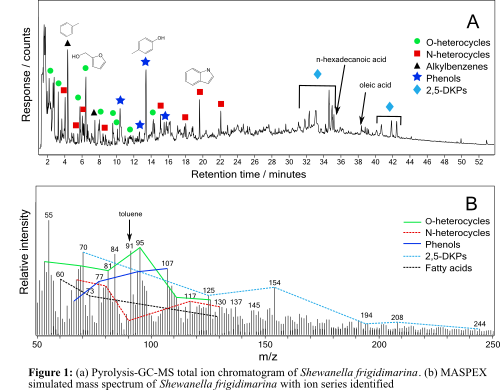Mass spectrometric fingerprints of Archaea and Bacteria for life detection on icy moons
- 1Department of Earth Science and Engineering, Imperial College, London, United Kingdom (t.salter@imperial.ac.uk)
- 2Southwest Research Institute, San Antonio, Texas, USA
Introduction: The potential habitability of the icy moons of Jupiter and Saturn, in particular Europa and Enceladus, has been hotly debated in recent years. There is evidence of subsurface liquid water oceans [1], and complex organic molecules (>200 amu) have been detected in the plumes from Enceladus [2]. Plumes are also thought to arise from the surface of Europa [3], which will be the target of the Europa Clipper spacecraft, due to be launched in a few years. In a similar manner to the Ion and Neutral Mass Spectrometer (INMS) on Cassini [4], the Europa Clipper will also carry a mass spectrometer, MASPEX [5], enabling molecular detection of material in the plumes.
Extremophile Archaea and Bacteria, besides being some of the simplest known forms of life, can withstand extreme conditions of temperature, salinity and acidity, and have been observed in hydrothermal vents on Earth. Similar organisms are the most likely candidates for life on icy moons.
The purpose of our current work is to study the mass spectral fingerprint of earthly simple Archaea and Bacteria to understand the spectra that would arise from similar organisms in the vicinity of icy moons and distinguish them from abiotic compounds. Nonbiological organic materials generally have complete structural diversity and are characterized by the presence of racemic mixtures and polycyclic aromatic hydrocarbons (PAHs). These are absent in biological materials which tend to have specific structures and show chiral preference.
Methods: Different strains of Archaea and Bacteria, including cyanobacteria, were obtained in freeze-dried form (DSMZ GmbH). These include extremophiles isolated from sea ice (Shewanella frigidimarina) and hot springs (Metallosphaera hakonensis). They were analyzed in pure form with flash pyrolysis-GC-MS. This enabled identification of the decomposition fragments that are representative of the different components of bacteria.
Flash pyrolysis offers a good analogue of the impact fragmentation that occurs as the spacecraft flies through a plume. In our experiments pyrolysis is coupled with gas chromatography-mass spectrometry (GC-MS). This separates the pyrolysis products, enabling identification of individual molecules. This GC stage is missing on the spacecraft instruments but simulated INMS or MASPEX spectra can be reconstructed from the chromatograms.
Additional experiments were carried out to understand the degradation of bacterial signals under conditions relevant to icy moons. Hydrous pyrolysis was used to simulate hydrothermal degradation, where bacteria are subjected to increased pressures and temperatures, in the presence of water [6].
Results: Our results show that pyrolysis-GC-MS analysis of intact archaea and bacteria produces distinctive fingerprints of biotic substances, shown in Figure 1. Decomposition products from protein, amino acid, carbohydrate and lipid species were detected from all the strains analyzed. The compound types detected are detailed in Table 1.
| Compound type | Possible origin |
| Alkylbenzenes, e.g. toluene, styrene, ethylbenzene | Protein |
| Nitrogen containing heterocycles, e.g. indole, benzyl nitrile, pyrrole | Proteins, amino acids |
| 2,5-Diketopiperazines | Peptides, proteins |
| Oxygen containing heterocycles (furans), e.g. methyl-furan, dimethyl-furan, furfural, maltol | Carbohydrates |
| Phenols, e.g. phenol, cresol | Protein, carbohydrates |
| Alkanes | Lipids |
| Fatty acid, e.g. hexadecenoic acid | Lipids |
Table 1: Possible origin of compound types detected from bacteria and archaea analyzed with pyrolysis-GC-MS.
Using GC-MS, we have been able to identify the molecules detected, shown in Figure 1A, and hence identify the ion series that represent specific compound types which are related to different components of the organisms. These ion series greatly help with the interpretation of complex mass spectra when no separation technique is present, i.e. in INMS and MASPEX. The chromatogram can be converted into a mass spectrum, Figure 1B, with lines joining the peaks in a specific series. This mass spectrum is more representative of the data acquired in space missions.

Although only a relatively small number of strains have been analyzed in this study, there is diversity among the results obtained with differing ratios of carbohydrate and protein products detected. However, all the strains also share common features, such as the presence of indole and phenols.
The mass spectra obtained from Archaea and Bacteria are clearly different from those of abiotic materials such as meteorites [7], which show features as discussed in the Introduction. This shows that mass spectrometry is a powerful technique for distinguishing between non-biological and biological materials.
As well as understanding the mass spectra of intact bacteria, it is important to understand how these spectra will change under different sample processing methods. Thermal processing is likely to be present on icy moons, both on and under the icy crust and as material is ejected into space. Hydrous pyrolysis can also simulate conditions near hydrothermal vents. Increased amounts of sample processing degrade the biotic fingerprint of the bacteria. Understanding the degradation pattern and being able to recognize where the spectral features originate from may play an important role in future spectral interpretation. It will also be important to note at what point the compounds detected become indistinguishable from abiotic materials.
Acknowledgments: We thank the MASPEX team for useful discussions.
References: [1] Pappalardo R. T. et al. (1999) J. Geophys. Res., 104 (E10), 24015-24055. [2] Postberg F. et al. (2018) Nature, 558, 564-568. [3] Paganini L. et al. (2019) Nat. Astron., doi:10.1038/s41550-019-0933-6. [4] Waite J. H. et al. (2004) Space Sci. Rev., 114, 113–231. [5] Brockwell T. G. et al. (2016) IEEE Aerospace Conference 2016. [6] Sephton M. A. et al. (1999) Planet. Space Sci., 47, 181-187. [7] Sephton M. A. et al. (2018) Astrobiology, 18, 7, 843-855.
How to cite: Salter, T., Waite, H., and Sephton, M.: Mass spectrometric fingerprints of Archaea and Bacteria for life detection on icy moons, Europlanet Science Congress 2020, online, 21 September–9 Oct 2020, EPSC2020-143, https://doi.org/10.5194/epsc2020-143, 2020

